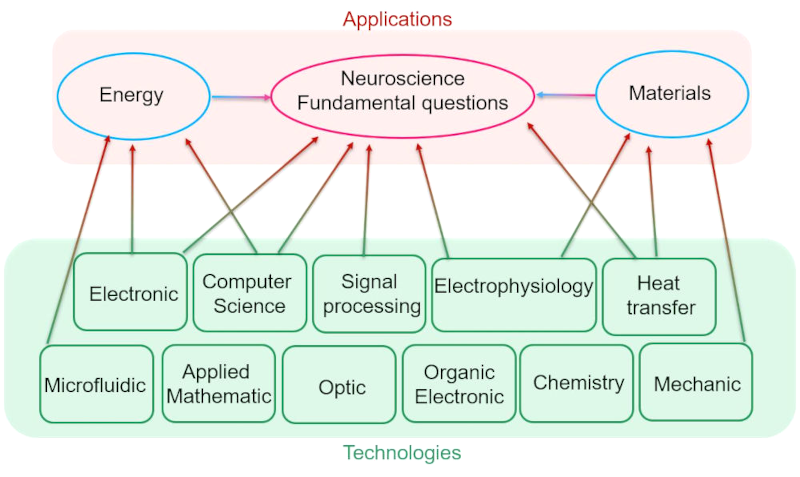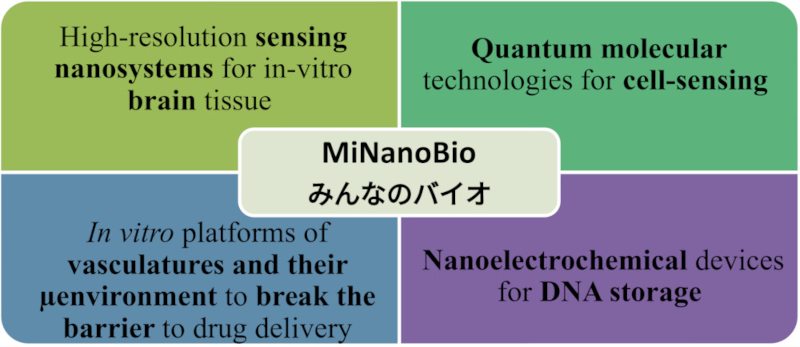The “International Project Team” initiative from the CNRS represents a strategic collaboration framework that fosters the sharing of human and facility resources to support research on specific topics. This partnership involves the Laboratory for Integrated Micro Mechatronic Systems (LIMMS) and a French CNRS laboratory affiliated with or connected to a university. These teams create a vital organic link between France and LIMMS, driven by the efforts of LIMMS alumni who lead projects, supervise students, or conduct research with LIMMS.
BIOMEG
Bordeaux IIS BiOMorphic Group
The objective of the BIOMEG team is to test different technological approaches across various domains (Electronics, Mechanics, Thermics, Chemistry, etc.) to address fundamental questions in Neuroscience and to design innovative multi-physical tools. BIOMEG is an international project team working on high-risk multidisciplinary projects.

Coordinators
- T. Levi, (IMS, U Bordeaux)
- T. Kohno (IIS, U Tokyo)
Participants
LIMMS: Takashi Kohno, Yoshiho Ikeuchi, Agnès Tixier-Mita, Soo-Hyeon Kim, Tsuyoshi Minami, Hiroshi Toshiyoshi, Yoshio Mita, Anthony Genot, Sebastian Volz, Kazuhiko Hirakawa, Naoji Matsuhisa IMS: Hamida Hallil, Sylvain Chambon, Florence Poulletier De Gannes, Damien Thuau, Mamatimin Abbas, Timothée Levi Collaborators: Jeremie Maire (I2M), Stéphane Chevalier (I2M), Dario Bassani (ISM), Reiko Oda (CBMN), Stéphane Grauby (LOMA), Stephan Dilhaire (LOMA), Pascal Branchereau (INCIA), Kishi Ishii (U Tokyo), Naomichi Hatani (U Tokyo), Shunsuke Yagi (U Tokyo)
Co-supervision PhD: Romain Beaubois, Jérémy Cheslet, Pierre-Marie Faure, Hugo Laval
TEAMS
Therapeutics and Engineering Against Metabolic Syndrome
Metabolic syndrome, MSy, refers to a complex disorder involving several tissues and organs and their interactions possibly resulting in diabetes, obesity, non-alcoholic fatty liver disorder (NAFLD). NAFLD is estimated to affect 24% of European adults. Its prevalence increases to 57% in obese subjects, 70% in diabetic subjects and 90% in morbidly obese people. The sequence of the development of the disease is still controversial. The systemic complications and the lack of pertinent human model of MSy lead to bottlenecks in risk evaluations, diagnosis, therapy and thus to industries (pharmaceutical, food industry) and clinical demands.
Because MSy is systemic disease, the technological challenges are to consider the interactions between the different organs. To our knowledge, there is no relevant in vitro human model of MSy and animal studies failed to produced data that can be extrapolated to human. To solve this problem, we propose a research program:
- To build an innovant in vitro human organoids/organ on chip solutions coupled with in silico simulations to generate a relevant systemic MSy models
- To investigate metabolic syndrome disease model with which we will track the heterogeneity and the kinetics of the disorders
- To identify biomarkers and therapeutic solutions regarding the disease specificity.
Laboratories
- UMR 7338, BMBI: Biomechanic and bioengineering, CNRS/UTC
- IRL 2820, LIMMS: Laboratory for integrated micro mechatronic system, CNRS/IIS
Coordinators
- E. Leclerc (CNRS, LIMMS),
- Y. Sakai (Univ. Tokyo, LIMMS),
- C. Legallais (CNRS/UTC, BMBI)
SUNRYSE
StructUred Nano-systems for eneRgY converSion and managEment
Energy control and conversion in opto/nano-electronic devices became one of the most important scientific, industrial, and societal issues to address in the current severe international energy crisis. It is now crucial i) to improve heat management in nanoelectronics to drastically reduce consumption and waste of thermal energy and ii) to develop much more efficient solar cells to converge towards a carbon-neutral society. Developing new concepts in nanophotonics is vital to achieve both. Addressing those issues requires a partnership between top international researchers with high scientific and technological standards. Moreover, the sustainability of such collaboration in top international circles must be based on nurturing young students and researchers. This is the central motivation and core of SUNRYSE’s scientific and pedagogical objectives, which originates from a fruitful and robust collaboration for more than five years.
The scientific aim of SUNRYSE IPT is to conceive and fabricate energy-efficient nanodevices in four crucial fields, which are:
- Heat management
- Bio-inspired light energy harvesting
- Radiative cooling in nanophotonics
- Biosensors & connected skin patch’s
Coordinators
- S. VOLZ (LIMMS)
- M. BESCOND (IM2NP – Marseille)
MiNanoBio
MIcro-&NANO-technology for BIO-engineering and bio-sensing
The MiNanoBio international project team, between LAAS-CNRS in Toulouse and LIMMS-IIS, is actively developing collaborative projects in the fields of bioengineering and biosensing, including exchange of knowledge and technologies. One direction is to establish advanced micro- and nano-technologies, as well as biophysical models, at LAAS, and subsequently integrate them into advanced bioengineered systems and applications at LIMMS. It is articulated around 4 research activities involving researchers from IIS and LAAS-CNRS:

Coordinators
- Yoshiho Ikeuchi ,LIMMS-IIS
- Guilhem Larrieu, LAAS-CNRS
Participants
LIMMS-IIS
- Ikeuchi Lab
- SH Kim Lab
- Matsunaga Lab
- Minami Lab
- Mita Lab
- Texier Lab
CNRS
- N. Clement
- A. Bancaud
- A. Genot
- G. Larrieu